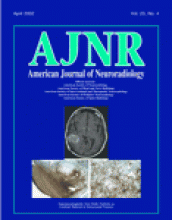Abstract
BACKGROUND AND PURPOSE: Recent neurointerventional and neurosurgical technologies require an understanding of lesions and adjacent structures in three dimensions. To clarify the clinical benefits of rotational 3D digital subtraction angiography (DSA), we retrospectively analyzed its advantages and disadvantages at the time of interventional procedures for ruptured cerebral aneurysms.
METHODS: From January 1998 through September 2000, 85 patients with a ruptured cerebral aneurysm were treated with Guglielmi detachable coils in the acute phase. Data for the patients treated before availability of 3D DSA (group A, 52 patients) were compared with data for patients treated after availability of 3D DSA (group B, 33 patients). Variables analyzed were age, sex, location of aneurysm, size of aneurysm, number of implanted coils, number of DSA exposures, and total amount of contrast medium used.
RESULTS: No statistically significant differences between the groups were noted when we compared the age, sex, aneurysm location, aneurysm size, and number of implanted coils. The number of DSA exposures was decreased in total by using 3D DSA (P < .0001), not only to determine the working projection (P < .0001) but also during the procedure (P < .0002). However, no statistically significant difference was noted in the comparison of total amount of contrast medium.
CONCLUSION: Three-dimensional DSA allows acquisition of high-quality 3D images of cerebral arteries and also allows observation and analysis from multiple directions to determine the appropriate working projection for embolization. Three-dimensional DSA is essential for optimal diagnosis and embolization of cerebral aneurysms and can reduce the number of exposures.
- Copyright © American Society of Neuroradiology












